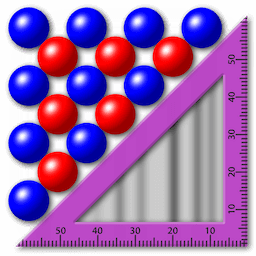

(The FCC crystal can also be viewed as made up ofrhombohedral cells, with the face-center atoms at the corners, and the other two corners theatoms with (x,y,z) = (0,0,0) and = (a,a,a) see Kittel,1966, Chapter 1.) Each corner atom is shared by eight cubes, and eachface-center atom is shared by two cubes. 2 the atoms on the three "far" faces and the "back" corner are shown as gray, while the atoms on the three "near" faces and the other corners are shown as black, as an aid to visualizing their three-dimensional locations, although of course all the atoms in an Aluminum crystal are identical. This pattern is repeated throughout the crystal in Fig. The FCC lattice has atoms at the corners of the cubes and at the centers of the faces. An example is aluminum, in which the arrangement is described as"face-centered cubic" or "FCC," see Fig. Typically only 1% will be coherently scattered to form the diffraction pattern.Ī crystal may be loosely defined as a piece of solid matter in which the atoms are regularlyarrayed in space. In X-ray diffraction from a protein crystal, for example, four-fifths of thephotons pass through undeflected and almost one-fifth are absorbed or are scatteredincoherently. Because the incident waves cannot provide a link tocoordinate the outgoing waves from the various atoms of a crystal, these incoherent processesare not responsible for any systematic reinforcement or cancellation of the waves scatteredfrom a crystal. The second class of events is everything else, known collectively as "incoherent scattering." If the wavelength is shifted, the particle's energy and momentum will have been changed, sothis class does include any "inelastic scattering." Compton scattering of photons by atomicelectrons is an example of such a process.

The first class is "coherent scattering," in which thefrequency and wavelength of the outgoing spherical waves are the same as the incident waves,and in which there is some fixed phase relationship, at the obstacle, between the two sets ofwaves. The various physical mechanismsresponsible, depending on the nature of the radiation and the obstacle, may produce eitherclass, or even both classes at once. Such scattering must be divided into two classes, based on the relationship between the incidentplane waves and the outgoing spherical waves. The spherical waves will not typically be equally intense in alldirections, but will instead usually be more intense at small scattering angles. Thus wecan see that the effect of a point obstacle in scattering a beam of particles may be described asdiminishing the intensity of the plane waves and creating outward-going spherical wavescentered on the obstacle. Particles headed in toward a common focus are described as ingoing sphericalwaves, and particles diverging from a common center are outgoing spherical waves. 1.Ī beam of particles all traveling in the same direction are described mathematically asplane-waves. This topic "brings you face to face with wave-particle duality" wave interference is observed by counting x-ray photons! For historical reasons, and forconvenience in parts of the mathematical analysis, the "scattering angle" or "deflectionangle" is called see Fig. The fineness of detail that can be studied by a given method (the "resolution") depends on thewavelength of the radiation used (the shorter the finer), the maximum angle of scattering thatis detected (the wider the finer), and the sensitivity of the sample to damage by the type ofradiation used (the less sensitive the more information can be extracted before the structurehas changed significantly). Examples of this approach include thevisible light and electron microscopes and the X-ray determination of the atomic coordinatesof crystallized protein molecules. One classical method of studying the structure of matter in fine detail is to shine a beam ofradiation on a sample and observe the outgoing radiation. Radiation Notes: Diffraction and Microscopy Notes on Modern Physics and Ionizing Radiation


 0 kommentar(er)
0 kommentar(er)
